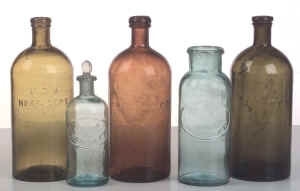One of the more intriguing areas
of Civil War medical antiquities involves the collecting of U.S. Army Hospital
Department bottles. These bottles,
simple in shape, and often unappealing in color, have been popular with
collectors for decades. Their
popularity springs from the fact that these bottles were produced during a very
narrow period of time (circa 1862-1865). Additionally,
they remained in use well into the post war years causing their survival rate to
be quite low.

Much of the history of bottles
marked simply “U.S.A. Hosp Dept” is clouded in time. However, we do know
something of their origin. Following
the Federal defeat at First Manassas and the grim realization that the war may
last years and not months, the Army Medical Department, under the auspices of
the Quartermaster Department, (the agency responsible for procuring supplies)
began purchasing standard medicines for the army. These medicines were normally packaged in several ways: in bottles, tins,
papers, and boxes. Army officers
seemed to prefer packaging in tins and bottles as these were more robust,
holding up to the rigors of the field better than packaging in fragile papers or
boxes.
For example, E.R. Squibb, a New
York contractor, provided a medical pannier for field use to the Army with 52
standard medicines all packaged in Japanned Tin containers at a cost of $100.00
per pannier. This item allowed the
field surgeon access to necessary medicines protected in a bound chest and
packaged in unbreakable tins. Large
numbers of surviving tins clearly illustrate the popularity of this form of
packaging.
Bottles, however, remained a
popular form of container for medicines throughout the war. The Army used both plain civilian bottles and the rarer Hospital
Department bottle.
According to Civil War bottle
authority Mike Russell, research indicates that Hospital Department bottles were
manufactured at factories in Pittsburgh, Pennsylvania and Baltimore, Maryland,
although archaeological evidence may point to a third manufacturing plant at St.
Louis, Missouri. Clearly, the
principal manufacturer was at Pittsburgh with the secondary manufacturer at the
Baltimore Glass Works.
Examples blown at the Pittsburgh
factory exhibit concave, slightly recessed, bases with a star design, initials,
or a simple dot. Occasionally, some bottles from this firm are seen with an iron
pontil scar (a result of an older glassmaking technique that used a rod dipped
in iron oxide to hold the bottle base during the manufacturing process). Baltimore Glassworks examples are flat based and exhibit weak embossing.
Civil War period bottle embossing
styles fall into several major types: (1) Two Straight Lines; the top line is
“U.S.A.” printed in raised letters. The
second line reads, “Hosp. Dept.” (2) “U.S.A Hosp. Dept.” embossed in an
oval. In this pattern, the
“U.S.A” curves along the top of the oval and “Hosp. Dept.” curves below
(3) “United States Army Hospital Department” spelled out in a straight line
(4) “U.S.A” arching over “Med’l Dept.” (This is the only style
incorporating the abbreviation for USA Medical Department dating from the Civil
War era.
Numerous bottle colors exist.
The most common color is clear followed by aqua. Rarer colors include cobalt (the most popular color with collectors),
emerald green, apricot and dense purple or puce. Hospital Department Bottles
range in size from a 2 ½ inch high oval shaped vial to a quart size 9 ¼ inch
tall cylinder. Neck styles vary from narrow openings to a wide mouth.
Whether the coloring or shape had any relation to contents is a matter of
conjecture, although bottles have surfaced with paper labels indicating their
original contents. Wide mouth bottles were probably used for pills.
Regardless of color, all original
bottles contain flaws in the glass, resultant of mid-nineteenth century
manufacturing processes. Bottles
often contain numerous bubbles, sand and some examples even show a primitive
whittled look. Lips are often crude
and appear hand tooled.
Archaeological finds confirm that
Hospital Department bottles were commonly used in the field after 1863 and that
they remained in use on the frontier until the 1870’s.
The
Hospital Department bottle was slowly replaced by one of similar design in the
post-Civil War years. The more
modern bottle employs various abbreviations of U.S. Army Medical Department.
Medical Department bottles remained in issue until WWII and are easily
distinguished from their Civil War cousins by the quality of the glass, more
refined lip and a base often designating the bottle capacity. The colors of post-war bottles are more standard with dark brown/amber
being the most frequently seen on the market.
Some
illustrations of various USA Hospital Bottles (click image to enlarge):
